36 Japandi Kitchen Ideas for a Serene, Stylish Cooking Space
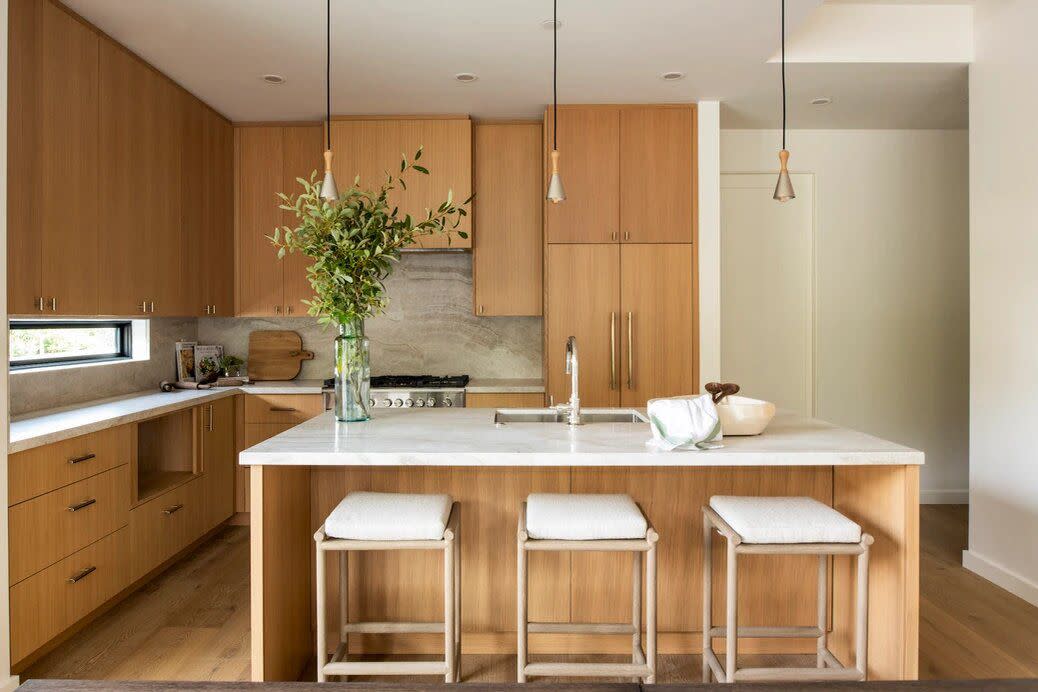
Japandi is the amalgamation of Japanese and Scandinavian designs, leaning into minimalism, natural materials, and an overall sense of balance. The result is spaces that feel peaceful, timeless, and yet extremely design-savvy—that's what makes it such a great choice for a kitchen.
To create a Japandi kitchen in your own dwelling, the following ideas are here to ignite a few sparks of inspiration.
Japandi, Explained
Mihoko Iida, a Tokyo-based writer, editor, and author of Japanese Interiors, notes that "Japandi is a concept created outside of Japan" that is somewhat of a phenomenon developed out of admiration.
"I think the term Japandi came about abroad because Japanese and Scandinavian people share a similar love for minimalistic and functional designs," she explains. "We both love natural elements and textures, too. And there’s always a sense of fun mixed in."
Interior designer Niki Tashe, who works at Kitchen Renovation Singapore, says there are a few characteristics you'll want to include when it comes to creating a Japandi-style kitchen.
"I start by focusing on simplicity, clean lines, and natural materials like wood, stone, and ceramic," he says. Lighting is also important, as is symmetry.
Layer Your Lighting
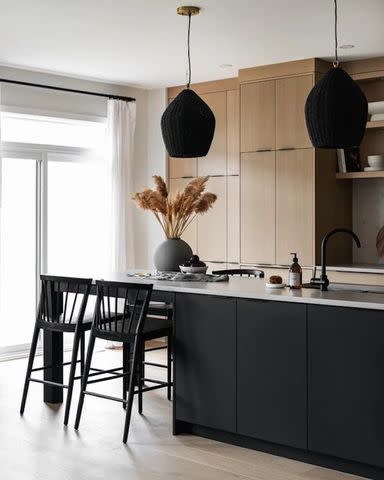
There can be multiple forms of lighting in a Japandi kitchen. When selecting the fixtures, look for minimal shapes and warm, earthy materials.
Tashe prefers "a layered approach" and achieves this through a mix of ambient lighting from recessed or track fixtures with task lighting over the countertops and a statement pendant light or two over the island or dining area.
Warm Up the Space
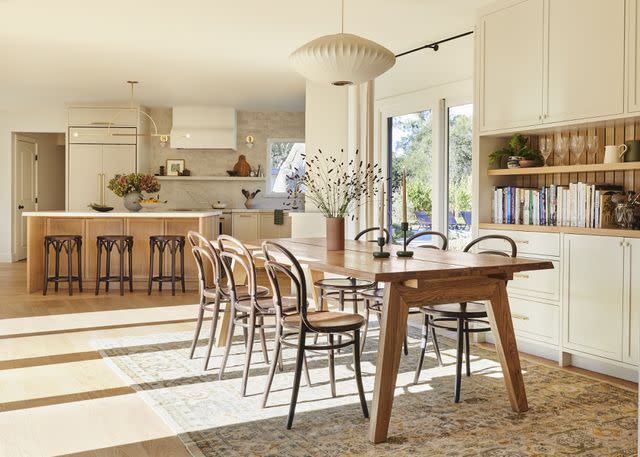
Design by Julie Rose for Velinda Hellen Design / Styled by Emily Bowser / Photo by Sara Ligorria-Tramp
One thing Scandinavian design excels at is keeping warmth and coziness in minimal spaces. If you've decked out your kitchen but it needs a visual "hug," elements like a soft rug, warm wood and clay or ceramic accessories, and ambient lighting will all do the trick.
Embrace the Wood Theme
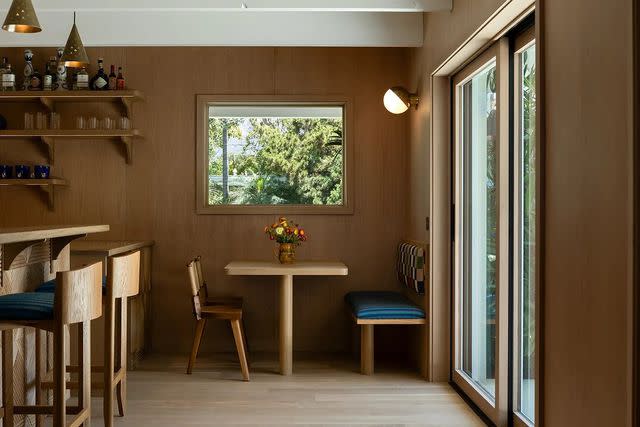
Wood shows up in nearly every Japandi kitchen, and it makes sense. Both Japanese and Scandinavian designs embrace this natural building material. It completely grounds the space it's in.
You could include wall panels that wrap around the kitchen and dining area. Tashe also suggests a stunning, live-edge wood countertop or island to anchor the space with raw, organic beauty.
Bring in Stone for Texture
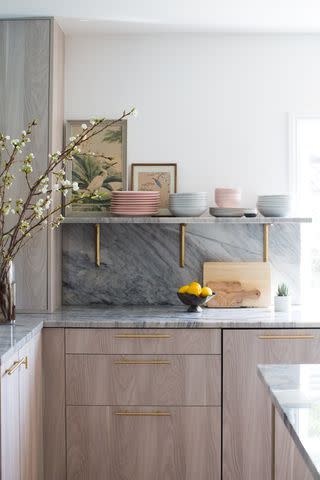
Busy patterns and textures won't be found in a Japandi kitchen. But if you are craving a little more differentiation in your space, the striations in various stone slabs are a great place to turn. It still looks natural and fits into the theme, but isn't overly noisy.
Go Dramatic with All Black
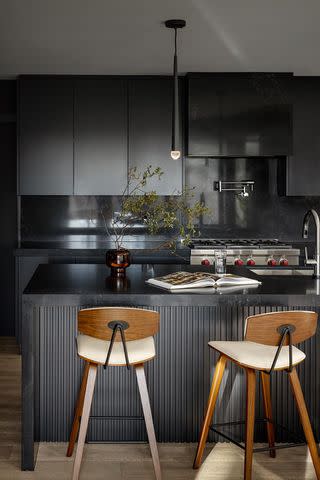
There's a quiet simplicity in the color black, but it also stands out from the extremely popular all-gray and all-white kitchens. In spaces embracing a monochromatic black palette, it's been to keep other colors to a minimum. A few wooden stools and a vase or colorful knobs is the right balance.
Incorporate a Large Plant
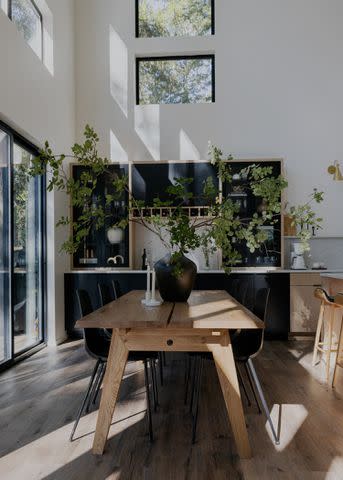
There's a deep respect for nature in Japanese and Scandinavian architecture and design. Giving plants and flowers a space in your kitchen can contribute to a Japandi atmosphere.
Place a large, vase with sculptural branches in the center of a table or island or give fresh flowers the spotlight somewhere in your kitchen.
Focus on the Backsplash
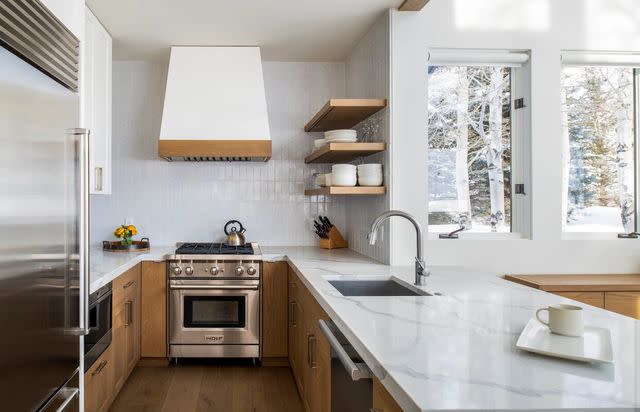
The backsplash is another area where Japandi styles can be woven in. Tashe recommends "traditional Japanese elements like washi paper or ceramic tiles arranged asymmetrically."
Stick white quiet tones of white, cream, beige, black, or gray. As for shape, consider subway tiles, squares, and other simple geometric silhouettes.
Go All Out with Minimalism
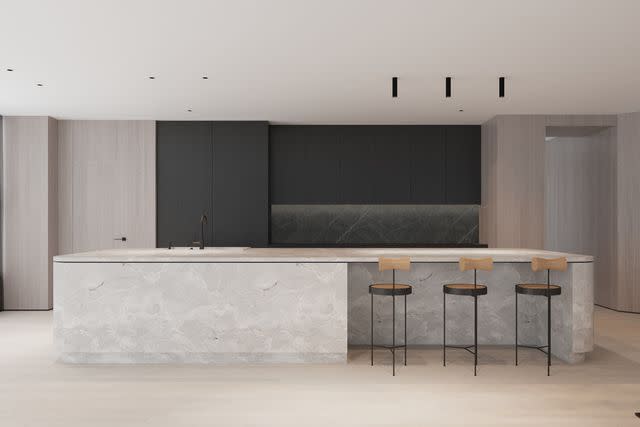
A Japandi kitchen shouldn't feel busy, overwhelming, or anything that veers into maximalist or cluttercore territory. There is room for all design types in the world, but these features aren't part of this quiet, streamlined style.
Select straight lines, soft colors, and natural materials—and keep appliances and utensils hidden away.
Select Sleek Surfaces
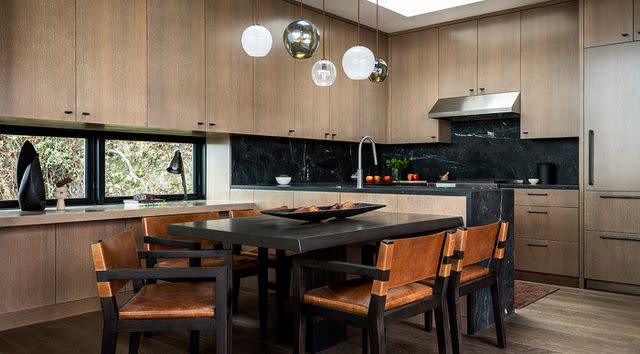
You can make an impact in Japandi kitchens with surfaces in deeply saturated (but neutral colors) like black. These can be displayed through stone, matte paint, or glossy tiles. Keep cabinets, range hoods, countertops, and backsplashes wiped down and gleaming for a sharp, sleek room.
Stick with Simple Lines

Japanese interiors do straight, simple lines best. You can adopt this look in your kitchen through everything from cabinetry to windows to seating. Curved lines are also seen in some spaces, whether it's through a vase or pendant light. But as a foundation, stick with linear, level lines.
Define Layers in the Space
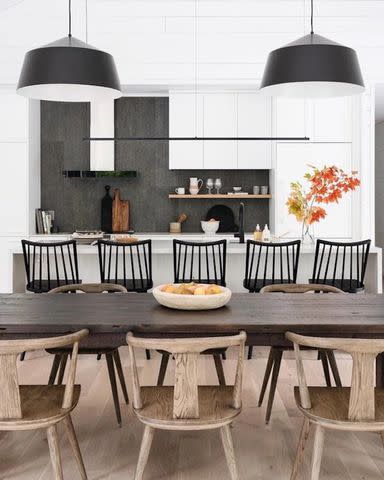
Japandi kitchens may be level and balanced, but they're by no means one-dimensional. Create visual layers in your cooking space through islands, tables, seats, shelves, and lights. Even with the most modest color palettes, it'll have movement.
Add Metallics for a Traditional Twist
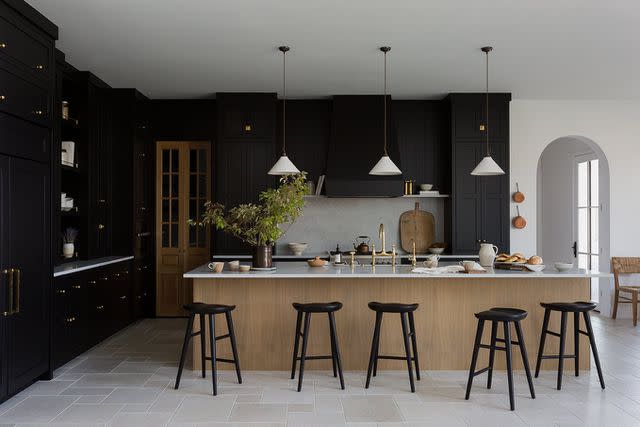
Save for stainless steel appliances, you won't find many metallic or flashy finishes in Japandi spaces. To blend this (already blended) style with another, bring in gold knobs, copper accessories, and traditional faucets.
Be Intentional with Decor
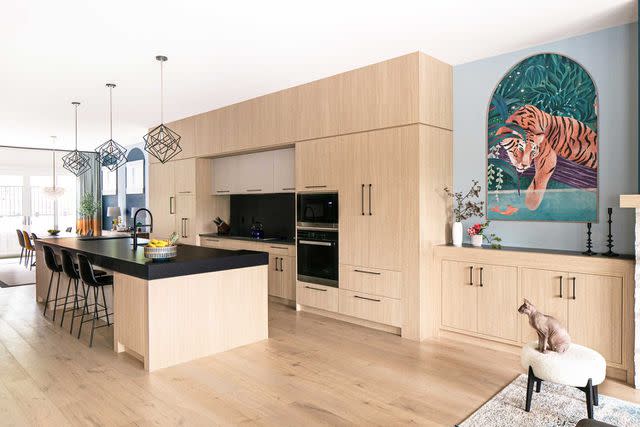
Japandi spaces aren't void of color or personality, but they're very intentionally decorated. It's not the best space to throw random finds you're unsure about. When you choose artwork, lighting, and even tiny details like cabinet pulls and candlesticks, really consider if it deserves a spot.
Use Symmetrical Tiles
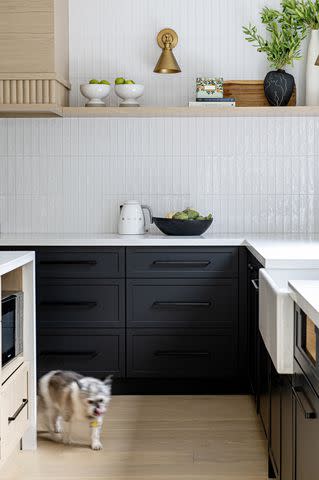
As Tashe notes, symmetrical tiles are essential in a Japandi kitchen. The orientation doesn't matter too much—you can opt for long vertical tiles or horizontal. To really nail down this style, using rectangular or square versions are best on backsplashes, walls, and other surfaces. Circular and hexagonal tiles stray a little too far.
Add a Coastal Spin
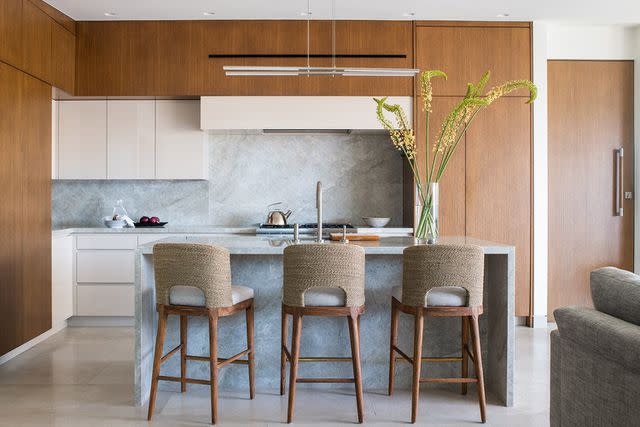
Japandi style looks fantastic in a modern coastal home. The natural materials found in Japanese and Scandinavian styles are often similar to those that crop up in beach houses. Woven textures, grasses, wood, plants, and stone are welcome in both kinds of spaces—making them the perfect match.
Hone in on Neutrals
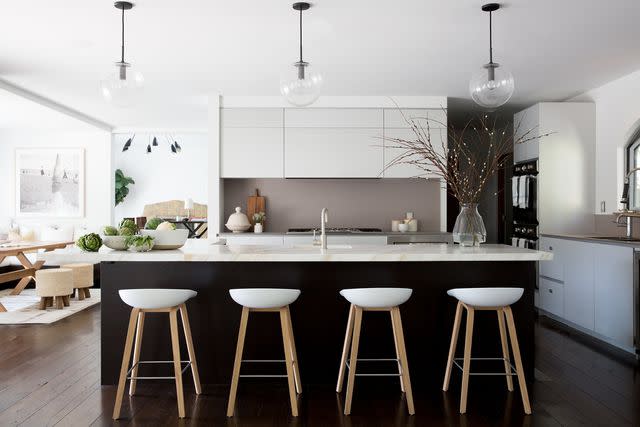
By now, you've probably realized that neutrals are the way to go in a Japandi kitchen (though thoughts on more saturated colors are still to come). Even with a limited set of colors, you won't be lacking when it comes to the number of configurations and combinations that are possible.
Center Minimalism Into Other Areas
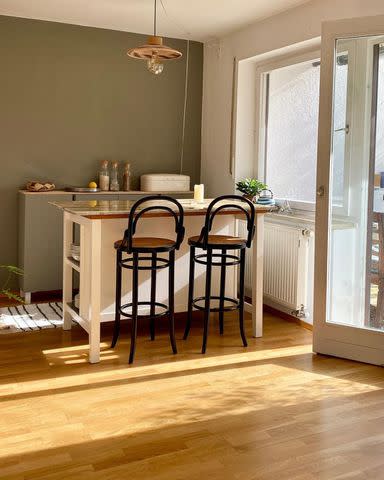
@afrobohemianliving / Instagram
If your kitchen is open plan or connected to a breakfast bar, keep the theme going. Cabinets, buffet tables, and movable islands are all still opportunities to embrace minimalism and keep surfaces clear, clean, and relaxed.
Keep Patterns Consistent
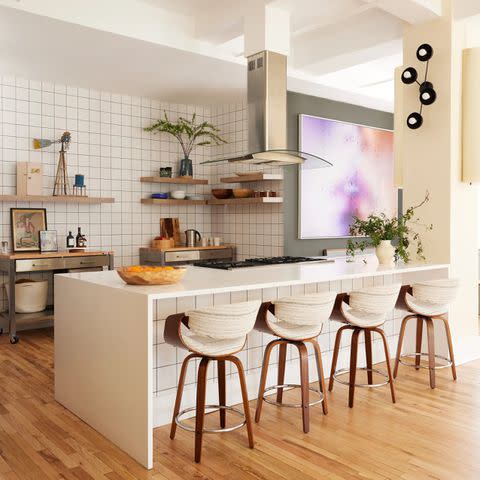
If you're opting for square tiles or a certain orientation of wood planks, keep that the same throughout the rest of your kitchen. Any kind of pattern like this can look wonderfully executed, but the second the direction, size, or color changes, it can start feeling a little less Japandi.
Match the Tone of Wood with Other Colors
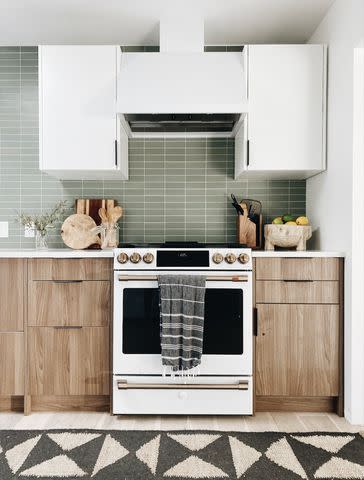
The undertones of paint, tile, and wood. can sometimes cause a space to feel like it's clashing. It could be the reason you can't quite put your finger on what's off about it. To keep fluidity in the palette, ensure you pick all warm or cool undertones across all of your materials.
Balance Black and White
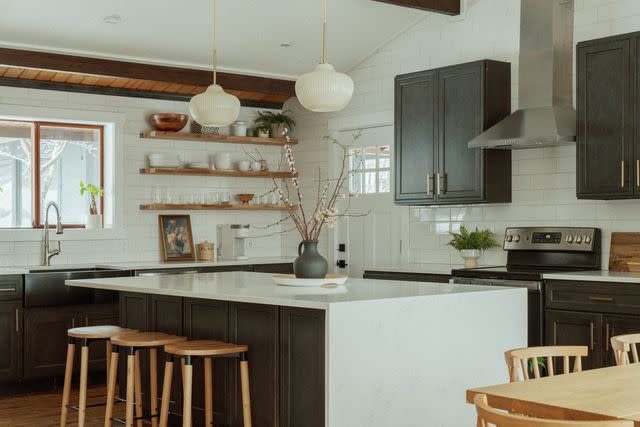
Balance is a major principle of Japandi design. To find equilibrium with a contrasting color palette, give equal attention to both black and white. If the cooking space has white walls and a white island, bring in black cabinetry and a black inlay. A few wooden elements can warm up the contrast, too.
Play with Color for a Unique Finish
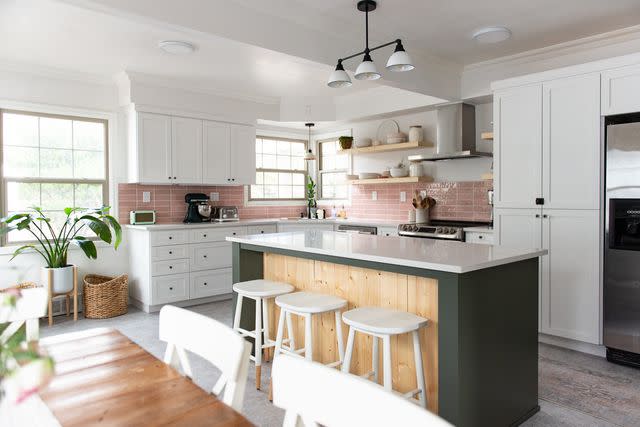
If you love the Japandi style but prefer more colorful palettes, don't be afraid to make it your own and introduce more saturated schemes. Design is all about creative expression and experimentation. Pink and earth green, for example, are a toned-down version of complementary colors that can be fun.
Consider Sleek Light Fixtures
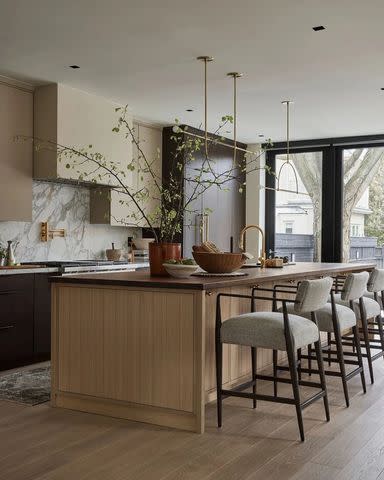
Lighting can be layered and a statement in itself in Japandi kitchens, or it can be subtler and blend in with its surroundings. If you're after the latter, hunt around for linear, rod-style lighting or slim vertical pendants.
Hold Onto Consistent Details in Small Cooking Spaces
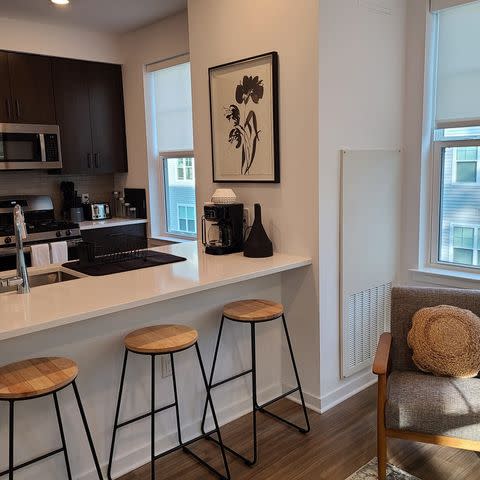
The tiniest kitchens can hold a lot of Japandi flair. Keep the color palette simple and show it through every detail. Say, your cabinets are black and countertops are white, then bring those colors in through artwork, accessories, and even your coffee machine. Modern wooden stools always help, too.
Seek Out Unique Details
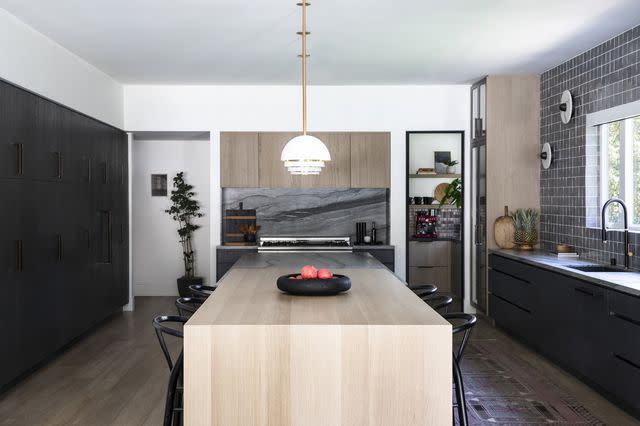
Although the same tactics, colors, and materials are applied throughout all Japandi kitchens, it's the unique details and method in which they're installed that makes these spaces look so different from one another. Wall-mounted lamps superimposed on small black tiles or a unique plant in the background does wonders.
Create Balance Across the Space
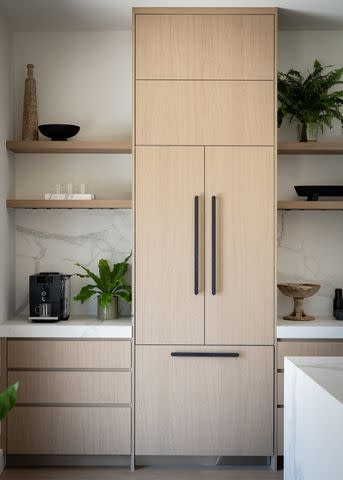
Don't just focus on one part of the kitchen to be balanced and uphold these looks for the rest of the space. You want everything to feel cohesive. Things like fridge handles should feel aligned with the doors, shelves on either side should match up, too.
Bring in Movement with Furniture and Decor
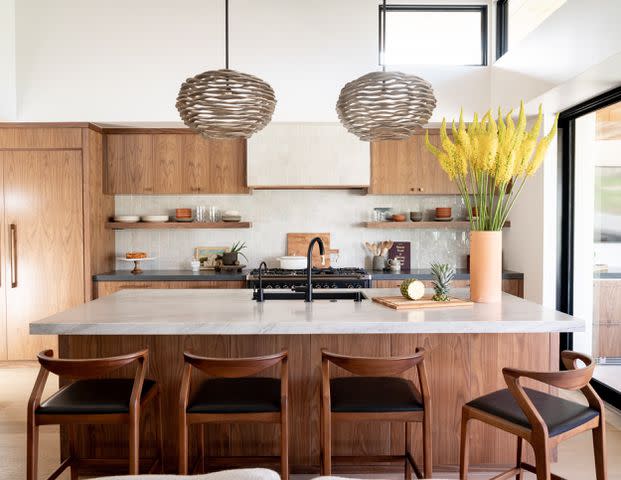
You don't want a kitchen to feel stagnant, so for visual movement, wavy chairs and rounded hanging lanterns can do just the trick. When the rest of the surfaces are so straight and angular, this gives a nice change for the eye.
Don't Forget the Appliances
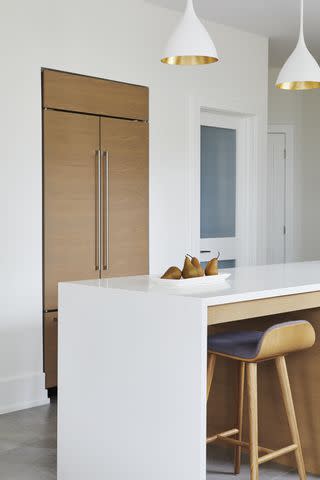
No hard feelings against classic stainless steel appliances, but there's something to be said for bringing in refrigerators, ovens, and stovetops that really blend into the Japandi look. A fridge with wooden panels or a sleek black iron range and hood really raises the bar.
Make a White Kitchen Pop with Wooden Seats
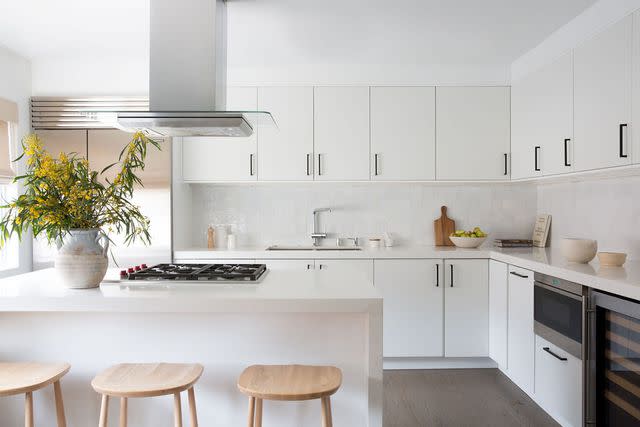
An all-white kitchen can be very Japandi, depending on the details you choose. If you find that you want a little differentiating feature, choose something like chairs or barstools to break up the look. Wooden or black always feels right at home in a bright, frosty cooking space.
Keep Hardware Simple
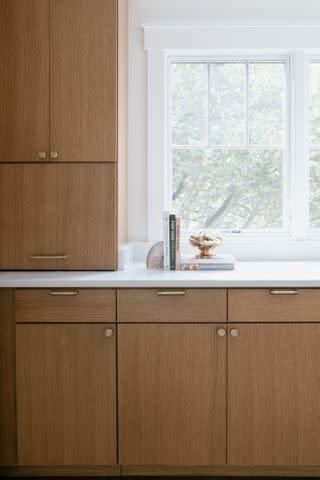
Forgo the crystal knobs and ornate pulls. In a Japandi kitchen, simplicity is best and this goes for details as small as cabinet and drawer hardware. If your eye is on a metallic texture, opt for a brushes or muted finish.
Blend Angular and Fluid Shapes
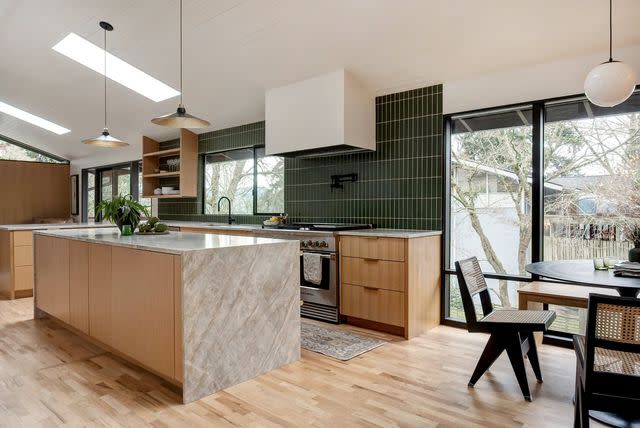
Angles and lines are spoken about a lot in reference to Japandi design. But a few rounded shapes and more fluid lines are welcome here, too. This could be rounded bulb pendant lamps, circular knobs on appliances or cabinets, tables, and rugs.
Mix Warm and Cool Tones
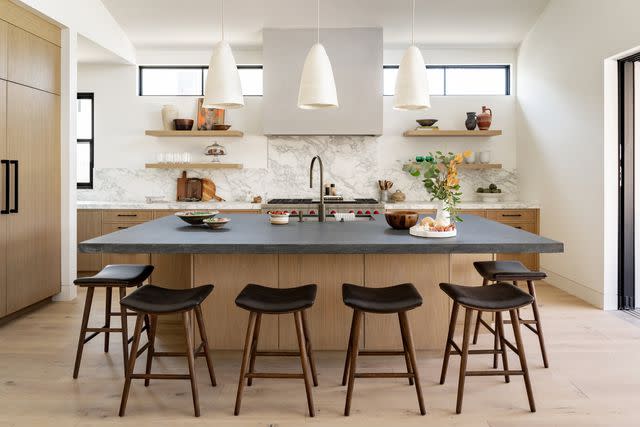
It's commonplace and usually recommended to keep tones consistent in a space. But if you're looking to venture out and spice things up, sometimes mixing tones can really pay off if done well.
Try a cool gray countertop with both light and dark wood cabinets and furniture for a nice contrast. Just weave in other parts of gray (like through your backsplash) to support it.
Avoid Intricate Structures and Fixtures
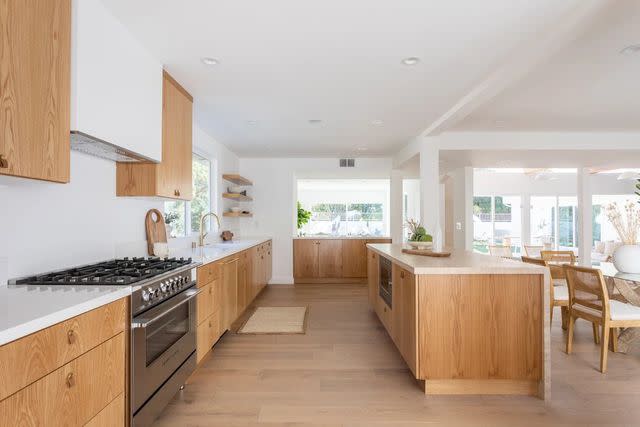
Convoluted layouts, ornate cabinets, and flashy backsplashes, chandeliers, or appliances aren't the best choices in a Japandi kitchen. Instead, keep the structure, layout, and foundational items simple in form.
Try Stone Slab Walls or Backsplash
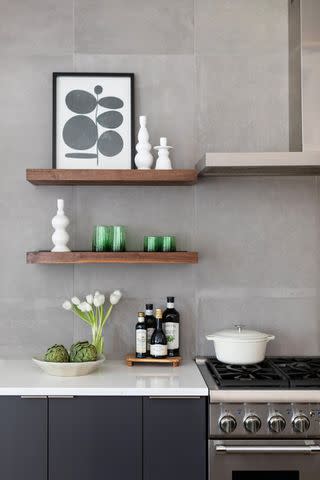
Rather than smaller tiles, slabs of stone are equally as chic in a Japandi cooking space. Gray, black, and beige colors all look nice stretching up walls. Keep grout lines thin and symmetrical for the cleanest finish.
Don't Fear Mixing Wood Types
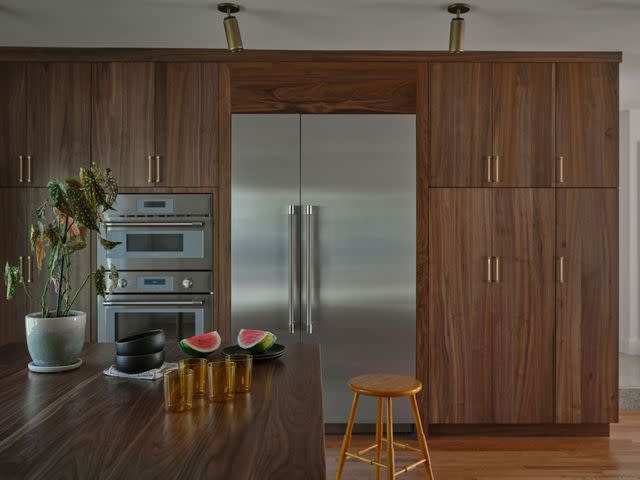
Consistency is key, but sometimes mixing different woods in a Japandi kitchen can look fabulous and still very on trend. For instance, if your flooring is one tone of wood and the cabinets are another, use tabletops, chairs, or stools, to keep mixing those tones together.
Choose the Right Tone of Color
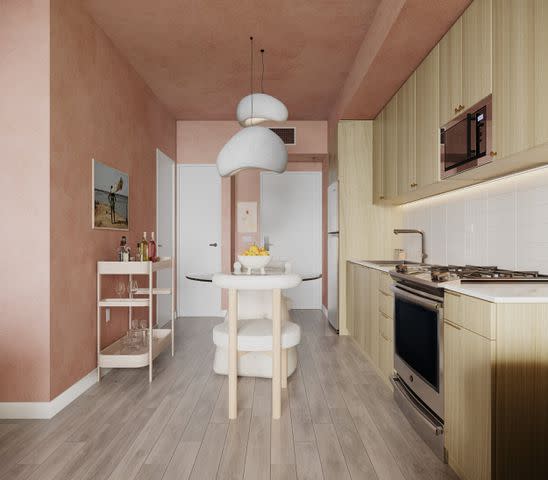
If you are going to expand beyond the classic neutral tones found in many Japandi kitchens, opt for those that are subtler, dustier, or toned down. For example, if pink is a favorite of yours, try to select a dusty rose or pale pink so it still fits in with the rest of the space.
Maintain a Flow
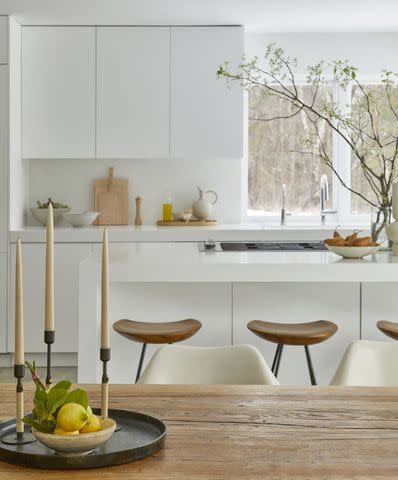
Aside from just the visuals of a Japandi kitchen, think about the flow and movement, too. How do you want to move around your cooking space? What do you need access to? Japanese and Scandinavian designs both largely embrace functionality as much as aesthetics.
Read Next: 32 Japandi Living Rooms for a Soothing, Minimalist Space
Read the original article on The Spruce.

